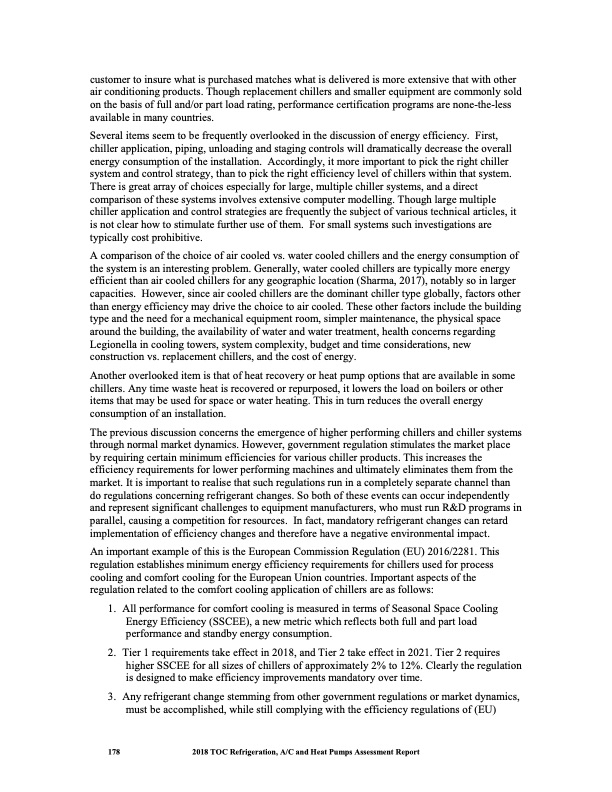
PDF Publication Title:
Text from PDF Page: 191
customer to insure what is purchased matches what is delivered is more extensive that with other air conditioning products. Though replacement chillers and smaller equipment are commonly sold on the basis of full and/or part load rating, performance certification programs are none-the-less available in many countries. Several items seem to be frequently overlooked in the discussion of energy efficiency. First, chiller application, piping, unloading and staging controls will dramatically decrease the overall energy consumption of the installation. Accordingly, it more important to pick the right chiller system and control strategy, than to pick the right efficiency level of chillers within that system. There is great array of choices especially for large, multiple chiller systems, and a direct comparison of these systems involves extensive computer modelling. Though large multiple chiller application and control strategies are frequently the subject of various technical articles, it is not clear how to stimulate further use of them. For small systems such investigations are typically cost prohibitive. A comparison of the choice of air cooled vs. water cooled chillers and the energy consumption of the system is an interesting problem. Generally, water cooled chillers are typically more energy efficient than air cooled chillers for any geographic location (Sharma, 2017), notably so in larger capacities. However, since air cooled chillers are the dominant chiller type globally, factors other than energy efficiency may drive the choice to air cooled. These other factors include the building type and the need for a mechanical equipment room, simpler maintenance, the physical space around the building, the availability of water and water treatment, health concerns regarding Legionella in cooling towers, system complexity, budget and time considerations, new construction vs. replacement chillers, and the cost of energy. Another overlooked item is that of heat recovery or heat pump options that are available in some chillers. Any time waste heat is recovered or repurposed, it lowers the load on boilers or other items that may be used for space or water heating. This in turn reduces the overall energy consumption of an installation. The previous discussion concerns the emergence of higher performing chillers and chiller systems through normal market dynamics. However, government regulation stimulates the market place by requiring certain minimum efficiencies for various chiller products. This increases the efficiency requirements for lower performing machines and ultimately eliminates them from the market. It is important to realise that such regulations run in a completely separate channel than do regulations concerning refrigerant changes. So both of these events can occur independently and represent significant challenges to equipment manufacturers, who must run R&D programs in parallel, causing a competition for resources. In fact, mandatory refrigerant changes can retard implementation of efficiency changes and therefore have a negative environmental impact. An important example of this is the European Commission Regulation (EU) 2016/2281. This regulation establishes minimum energy efficiency requirements for chillers used for process cooling and comfort cooling for the European Union countries. Important aspects of the regulation related to the comfort cooling application of chillers are as follows: 1. AllperformanceforcomfortcoolingismeasuredintermsofSeasonalSpaceCooling Energy Efficiency (SSCEE), a new metric which reflects both full and part load performance and standby energy consumption. 2. Tier 1 requirements take effect in 2018, and Tier 2 take effect in 2021. Tier 2 requires higher SSCEE for all sizes of chillers of approximately 2% to 12%. Clearly the regulation is designed to make efficiency improvements mandatory over time. 3. Anyrefrigerantchangestemmingfromothergovernmentregulationsormarketdynamics, must be accomplished, while still complying with the efficiency regulations of (EU) 178 2018 TOC Refrigeration, A/C and Heat Pumps Assessment ReportPDF Image | Heat Pumps Technical Options

PDF Search Title:
Heat Pumps Technical OptionsOriginal File Name Searched:
RTOC-assessment-report-2018_0.pdfDIY PDF Search: Google It | Yahoo | Bing
CO2 Organic Rankine Cycle Experimenter Platform The supercritical CO2 phase change system is both a heat pump and organic rankine cycle which can be used for those purposes and as a supercritical extractor for advanced subcritical and supercritical extraction technology. Uses include producing nanoparticles, precious metal CO2 extraction, lithium battery recycling, and other applications... More Info
Heat Pumps CO2 ORC Heat Pump System Platform More Info
| CONTACT TEL: 608-238-6001 Email: greg@infinityturbine.com | RSS | AMP |